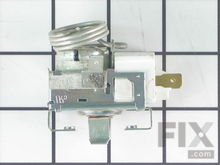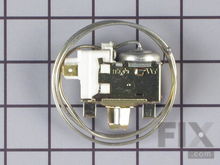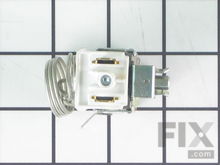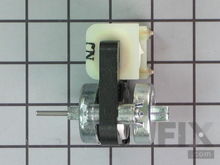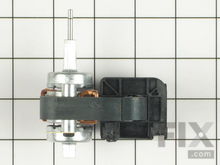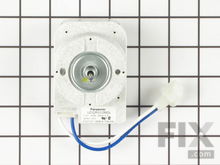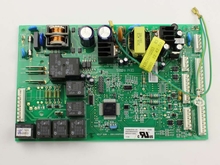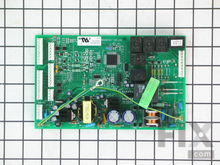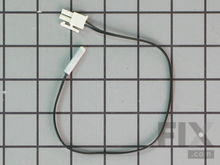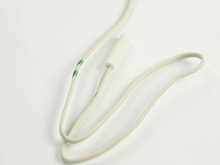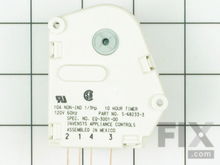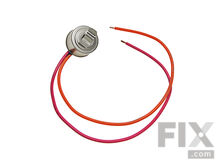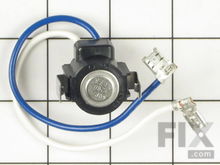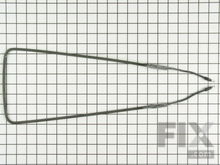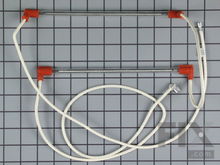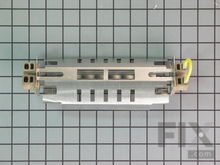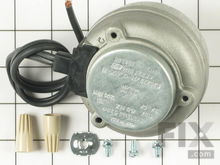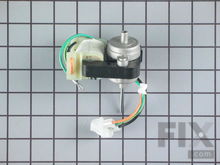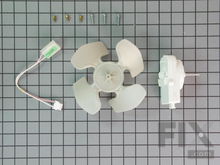How To Repair A Refrigerator and Freezer That Are Too Warm
- Rated as EASY
- 785 repair stories
- 8 step by step videos
Cold Control or Temperature Control
When your fridge won’t start and even the fans are not running, it could be due to a problem in the cold control, a switch to send electricity to the fans and compressor that is triggered by temperature change. When the compressor that makes the cold air and the fans that distribute it are operational but not getting the job done, it may be because the cold control hasn’t correctly communicated the actual temperature inside your fridge or freezer. Unplug the fridge. Find the cold control: it will be the knob with a range starting at “off,” inside your fridge, where the food’s stored. When the knob is at midpoint of its range, the fridge should be at about 38 degrees F. Check to ensure that the sensor wire or bulb is in its place and shows no sign of damage. Inspect the wire terminals on the control to make sure they’re not corroded or loose. And use your multi-meter to make sure the control itself has continuity.
Evaporator Fan Motor
Is your freezer not as cold and your fridge getting warmer? Does it seem like the fridge is always cycling on or stays on longer than before? You may have a problem with your evaporator fan motor, which ventilates the evaporator coils during the periods the compressor runs, and can be found in the freezer compartment. It is supposed to turn on when the compressor does, and you ought to be able to hear the fan in the freezer compartment, and feel the air moving in there. Unplug the fridge and take off the cover from the evaporator fan, located on the backside of the back panel of your freezer compartment. Is the fan clogged up with frost or ice? That means there’s a problem with defrosting. Is there damage to the fan blades, or are they loose? You will need to replace those. Use your multi-meter to check the motor to ensure continuity. Check to see if the motor shaft turns freely: if not, you may need to look into a new motor. If the cause of the noise still isn’t obvious, have a service technician in so that the power can be reconnected to isolate whether electricity is being fed to the motor. Don’t try this on your own, though, since live voltage is dangerous.
Electronic Control Board
If you have a newer fridge, the compressor, fans, defrost system, and temperature might all be under the authority of an electronic control board. This makes home repair trickier, because the control board determines so much, plus an electronic control board is costly and complicated. And for that same reason, it makes sense to eliminate other causes of fridge malfunction before you decide the electronic control board is the broken component. So if the fridge is not getting properly cold, verify that power is being supplied to the compressor from the control board. Check the external controls and the temperature sensors. Unplug the fridge and inspect the control board for evidence of burnt connections, deteriorated foil, or signs that arcing has occurred. Check your owner’s manual or manufacturer’s website to see if they have provided information on how to diagnose a problem in this component.
Temperature Sensor or Thermistor
If your fridge has an electronic control board, its temperatures are being overseen by a temperature sensor or thermistor. This is normally located near the air inlet and it is usually a capsule, enclosed in plastic, with two wires attached to it. The information from the sensor’s resistance to temperature will control the operation of the fans, compressor, and maybe even the damper. So a damaged or malfunctioning sensor could be at fault for a warm fridge or freezer, since it wouldn’t be signaling to the control board to turn the fan and compressor on. Check your owner’s manual or manufacturer’s website to decode the fault code, if you have one, or to find a diagnostic procedure for isolating problems in the temperature sensors.
Defrost Timer
When your compressor’s been running a total of eight to ten hours – that’s about every day or two days – the defrost timer will start a defrost cycle, shutting down the compressor for 20-30 minutes to allow the evaporator be defrosted by the defrost heater. So if the defrost timer is malfunctioning, the frost will build up on your fridge, or indeed the compressor may not be started up again at the end of that defrost cycle. And that could explain why it warmer than it ought to be. Depending on your model, you might find the defrost timer behind the kick plate at the bottom front of the fridge; as part of the control panel in the main body of the fridge where the food is kept fresh; or in a side-by-side unit it might be in the back. If your owner’s manual or manufacturer website has a wiring diagram, locate the terminals on the defrost timer upon which to perform continuity checks for the motor or the switch. One additional test would be on the harness leads to the defrost heater. This is a job for a service technician, though, because of the risk of electrocution during a live voltage test.
Defrost Thermostat
If your refrigerator is not defrosting, then it may not be able to get cold enough. This could be due to a malfunction of the defrost termination thermostat. This is the component in charge of turning off the defrost heater at the end of the defrost cycle, when the evaporator gets up to 38 to 47 degrees F. It can normally be found on the evaporator tubing. Its circuit will close when the temperature dips below 15 degrees F, so you will only be able to perform a multi-meter check for continuity of this thermostat in an environment of that same 15 degrees, with the fridge unplugged to eliminate the chance of electric shock.
Defrost Heater
During the defrost cycle, the defrost heater thaws the frost and ice off the evaporator coils. Some evaporators have several heaters on them. A defrost heater is composed of a wire inside an aluminum or glass tube, below the evaporator coils. Unplug the fridge and remove the evaporator cover from the back of the freezer compartment. Then locate the heater tube(s) and perform a multi-meter test for continuity.
Condenser Fan Motor
If your fridge is a newer frost-free model, it will likely have a condenser coil that’s kept cool with a fan. This fan keeps air moving for two reasons: to dry up the water that gathers in the drain pan as things defrost, and to keep the condenser coil properly cool. The motor for this fan turns on simultaneous to the motor for the evaporator and the compressor, so a malfunction in the condenser fan motor could be causing your fridge to cycle on and off more frequently or run too warm as well as too noisy. The condenser fan motor is usually on the bottom of the fridge near the back, conveniently close to the compressor. Start your inspection by unplugging the fridge and taking off the access panel at the back. The fan needs to move freely, so remove any rubbish that would block the blade’s movements. It’s a good habit to vacuum the area on a regular basis. Also check for wear on the motor or blades, or signs the motor has seized and must be replaced. Use a multi-meter to check the motor for continuity. If the blades or rubber mounting grommets are worn or damaged, switch them out for new ones.
More Repair Parts
Still not sure which part is broken? We can offer you custom troubleshooting help if you search with your model number.





